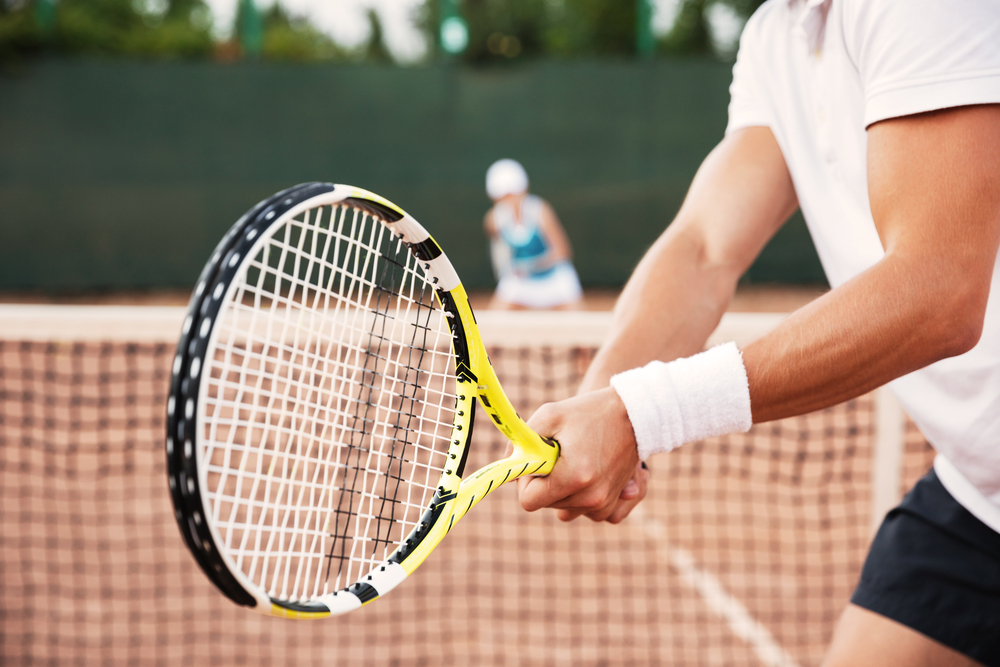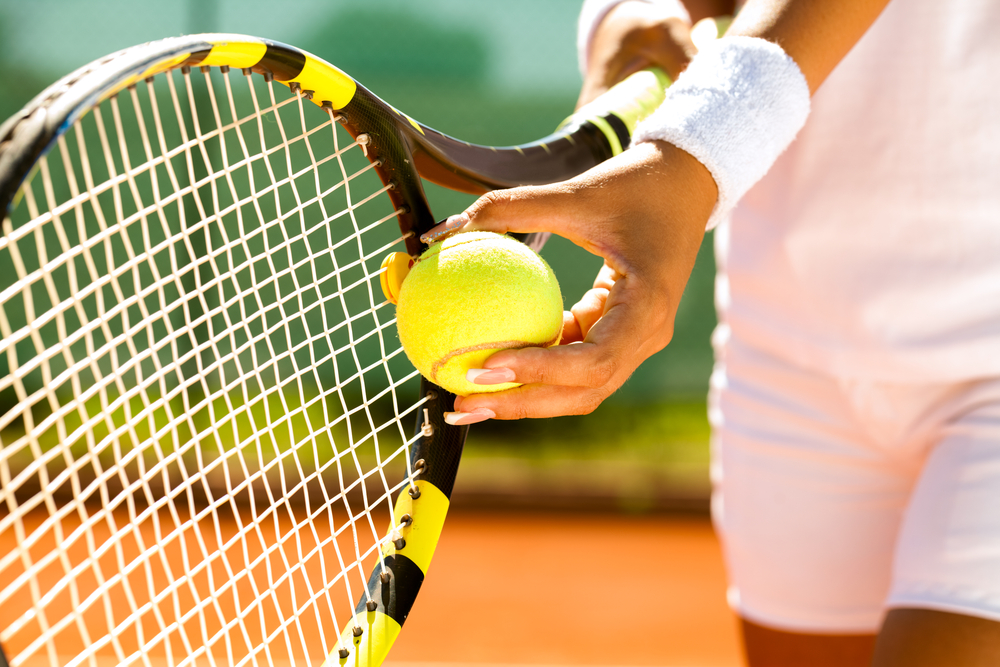Tennis rackets come in an assortment of weights, shapes, and sizes, which makes it difficult to choose the perfect one for you. Even within one brand, there are dozens of different series produced, with new ones coming out each year!
Just look at Wilson, who currently offers 55 different rackets in their online stores (and this isn’t accounting for the discontinued series of the past). For someone newly entering the tennis scene, finding the perfect racket is one of the most daunting first steps.
Rest assured, you can’t choose the “wrong” racket, but you will find that some rackets are much more suitable for some players than others. So, whether you’re a beginner, intermediate, or even advanced player, our guide has advice on what tennis racket might be the best to go for.
Contents
Overall Considerations
When it comes to rackets, there are some general categories that they may fall in. As you consider your purchase, you want to ensure that it suits your overall play style so it’ll enhance your game, rather than hinder it. You’ll also want to make sure that any racket you purchase will satisfy tournament rules. Before you start shopping around for rackets, make sure you know what your personal preferences are.
Cost
Start by outlining a budget for yourself. The most expensive rackets aren’t necessarily the best choice for you, and some definitely cost more than it’s worth. Take a look at the limited-time release of Roger Federer’s 20th Grand Slam commemorative tennis racket, which fetches a price of over $20,000!
Even within the racket market for causal, amateur players, rackets can range from $30 to $500, just from within the Wilson brand. Head to your local Walmart, and you’ll see most brands have rackets that run the entire price range.
The best rackets aren’t determined by their price point, but rather by how well they pair with your play style. If you’re just a beginner, start out with a less expensive one first to figure out how you play before investing in a higher quality racket.
Racket Play Styles
Typically, there is a range for what a specific racket may excel in. You have rackets that are good at control and consistency on one end of the spectrum, for players who like putting extra spin on their rackets or fine-tuning their aims.
You have rackets that are good at putting on extra power, hitting winners at the expense of less control over the place the ball lands. In between both of these, you have tweeners, which mixes the amount of power and control for players who would like to try the best of both worlds.
One racket type is not better than the others, especially when it comes to tennis. Power rackets are good at hitting strong shots that may end the game earlier, and for players who like to play aggressively, this type of racket helps them pull out extra points.
However, players with control rackets find themselves putting more spin on the balls, and are better suited for playing defensively rather than aggressively. The best racket differs on an individual basis, and for you, it’ll be the one that meshes with your gameplay.
Racket String Types
Beginners will typically opt for a racket that comes with pre-installed strings, which can be a cheaper option for those who are just getting started. However, you’ll find that more expensive rackets may come with only the frames, and you’ll have to pick the string type yourself. While we won’t get too deep into the best tennis strings for you, we will cover the way the frames may affect the strings.
The frame will either be suited for an open or closed pattern. Open patterns help the player put more power and spin behind their strokes. However, due to the lower amount of strings, it is also a little less durable than a closed pattern.
Once you play regularly, you’ll have to replace and restring these rackets more often. Closed patterns are denser, and as a result it adds more control to the racket. It won’t add as much power or spin to the ball as an open pattern, but it’ll be easier for you as the player to fine-tune the shots that you want to hit back.
Personal Play Style
Do you enjoy running up to the net for volleys? Or perhaps you prefer to stay at the baseline and hit deep topspin shots back? Depending on the way you best enjoy the game, your racket should be one that enhances your strengths. A power player is not well suited for a control racket, while a consistent player may not be interested in a power racket.
Regardless of the type of player you are, the right racket can help you enhance your game. If you take a look at professionals, you’ll notice that they all have their own racket types, play styles, techniques, yet they’re all at the top of the game!
Your play style will not limit your success in tennis, and picking the right racket to capitalize upon it will boost your play in your local tournaments or rallies with friends.
Age
This article will mostly cover choosing the right rackets for adult players, though all of the advice can be extended to junior players as well. Keep in mind that the sizes will be smaller for junior players, and there may be less variety in choices.
Specifics of Racket Compositions

Hopefully, you now have a general idea of what to look for in a tennis racket. It’s time to dive deeper into racket specifics. By the end of this section, you’ll have an idea of what you want your ideal racket shape, weight, and size to be.
For each component of the racket, you’ll notice that there’s a spectrum of weights, lengths, sizes, and shapes to choose from. Finding the perfect mix between something that will add control to your strokes vs. something that will add power to your strokes is key to finding the perfect racket.
Racket Weights
The weight of a racket affects more than just how it feels in your hand. With it comes implications for how it affects the power behind your shots, the control, and potentially the swing speed of your strokes.
Lighter rackets run around 9 or 10 ounces which lends itself to higher power shots by the player. Many, though not all, professional players may want to go this route as their skills would add their own spin and control to this fast-paced game. They’re easier to swing quicker, which is an advantage for gameplay close to the net.
Heavier rackets usually weigh around 11 ounces or more, and can lead to stronger shots by players. These rackets are good for players who have longer, faster swings to counteract the racket’s weight, and can lend itself to higher control for the players who use it. They’re a little slower to swing, so players with this racket may find themselves often at the baseline, preferring it over the net game.
As with anything on rackets, there is always a spectrum for weights. Rackets in the middle are considered tweener rackets, and are usually not too light for controlled shots, but not too heavy for fast reactions at the net.
This increased control calls for a sacrifice in power generated, while more power calls for a sacrifice in control. In the end, as long as you understand the difference a racket’s weight causes in-game, you’ll have a better understanding of a range of weights that you want your racket to be in.
Head Size
Racket heads range anywhere from 85 square inches to over 116 square inches. The larger the head size, the more powerful the shots hit with it will be. In addition, larger sizes give players a larger “sweet spot” so that players are more likely to hit a strong shot back rather than framing the ball.
However, this larger size comes with a cost, which is the lack of control someone may have over the shot. Many advanced players tend to opt for a smaller head size, since they’ve played long enough to be able to return shots consistently with it. The normal racket sold is about 100 square inches, which is a nice balance between power and control.
Swingweight
Swingweight is how hard it is to swing the racket, and how heavy it feels mid-swing.
Rackets that have higher swingweights are harder to swing, but give greater power and stability when you do make contact with the ball.
Lower swing weights are easier to stroke with, but there’s less stability involved, which may result in less control and power over your shots.
Stronger and more skilled players typically prefer rackets with higher swingweights since it allows them to return hard shots with equal amounts of power. However, this does come at the cost of needing more energy to swing the racket as fast as you might need during a fast-paced game.
Length
Rackets are usually around 27 inches, but once again, there’s a spectrum that runs from 26.5 to 29 inches. For tournaments, rackets are not allowed to be greater than 29 inches. Longer rackets can help players reach groundstrokes that are a bit further away, but adds on to the higher weight of the swing which may make it difficult to maneuver.
It’s made up for by having extra power added to the shots. Shorter rackets have a lower weight to the swings, but are easier to maneuver which makes it ideal for fast reactions at the net, and a better chance to hit winners off of your volleys.
Balance
Balance is easier to determine compared to the other components. A racket will either have a heavier head, a lighter head, or an even balance of weight between the head and the grip. Heavier heads have – you guessed it – a head that that is heavier than the grip. This makes it easier to hit more power shots for the player. Meanwhile, lighter heads have a heavier body or grip, which lets players exert more control over their return shots.
Flex/Racket Stiffness
The flex is a measure of how stiff a racket may be when you play with it. A flexible racket can absorb more momentum of the ball when it hits it, and as a result, players have more control when redirecting the shot back.
However, by absorbing the momentum, players often have to use their own power to send back a strong stroke rather than the power the ball had as it came in. More flexible rackets are typically an aspect of control rackets.
Stiffer rackets don’t absorb as much momentum, but the balls hit are stronger as a result. This excess power may take away from the control the player wants to have on the ball, but could be suitable for those who are incapable of generating enough strength for a powerful shot on their own. In addition, these rackets transfer greater amounts of vibrations to the wrists and arms, which may lead to issues down the line unless the players use a dampener.
Grip Size
The size of the grip could detract from the comfort of the racket if you’re not careful. Since you’ll be holding the grip the entire match, you want to make sure that it’s the right size for your hand. When shopping for rackets, it’s common to buy one with a grip size that is slightly smaller, as many people prefer to add on overgrips to the racket that are regularly replaced. Almost every tennis brand offers overgrip choices for the racket that comes in many colors. Players sometimes customize their rackets with colorful overgrips and strings as well.
Suitable Racket Qualities for Beginners vs. Advanced Players

Beginners and Experts in most sports have a need for different types of equipment, and the same is true for tennis. However, even players at the professional level sometimes favor rackets that most would consider for “beginners,” so don’t be put off when choosing a racket that you instinctively feel suits you.
That said, tennis is a tough sport, and have appropriate equipment will go a long way to helping you compete at your competition level.
Here’s a breakdown of the sort of rackets that might be suitable for you.
Beginner
- Larger head size for easier contact with the ball
- Lighter weights for lower swingweights
- Stiffer rackets for improved power
- Cheaper options until you determine your play style
- Heavier or balanced heads
Advanced
- Smaller or midrange head size for improved control
- Medium or heavy weights
- Flexible rackets
- Personalized strings
- Lighter or balanced heads
Advantage, You
Regardless of your experience, finding the perfect racket can make or break your matches. Shop around the various brands to find a racket that enhances your techniques and skills for upcoming matches. Find an idea of how you would like to play, and pick out the perfect racket with the right head size, weight, and length that suits your game style.
Our site has some recommendations for rackets if you’re still feeling lost, or you just want some direct recommendations out of the best out there on the market. You can easily narrow down that list with specifications that match your style of play. At the end of the day, there’s no one racket that’s considered superior to the rest. Your racket and gameplay are what you make of them, and experimenting with different rackets and styles could help you push to that next level.
